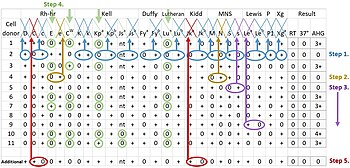P1PK blood group system

P1PK (formerly: P) is a human blood group system (International Society of Blood Transfusion system 003) based upon the A4GALT gene on chromosome 22. The P antigen (later renamed P1) was first described by Karl Landsteiner and Philip Levine in 1927.[1] The P1PK blood group system consists of three glycosphingolipid antigens: Pk, P1 and NOR.[2][3] In addition to glycosphingolipids, terminal Galα1→4Galβ structures are present on complex-type N-glycans.[4] The GLOB antigen (formerly P) is now the member of the separate GLOB (globoside) blood group system.
P1PK antigens
The P1PK antigens are carbohydrate antigens that include Pk (Gb3), P1 and NOR1, NORint and NOR2. All are synthesized by Gb3/CD77 synthase (α1,4-galactosyltransferase, P1/Pk synthase).[5]
- Pk antigen is a receptor for
- P1, P, Pk and LKE antigens all serve as receptors for P-fimbriated uropathogenic E. coli (cause of chronic urinary tract infections).[2]
The presence or absence of P1 antigen depends on the A4GALT transcript level. It was found that differential binding of transcription factors
P1PK phenotypes
P1PK phenotypes are defined by reactivity to antibodies to anti-P1, anti-P, anti-Pk anti-PP1Pk. and anti-NOR antibodies.
- P1 Phenotype: anti-P1 (+), anti-P (+) and anti-PP1Pk (+) and anti-Pk (-).Found in 95% of Blacks and 80% of Caucasians and 30% in Japanese.
- P2 Phenotype: anti-P1 (-), anti-P (+), antiPP1Pk (+), and anti-Pk (-). Found in 5% of Blacks and 20% of Whites.
- Rare p phenotype (absence of P1PK antigens caused by null mutations in A4GALT): anti-P1 (-), anti-P (-), anti-PP1Pk (-), and anti-Pk (-). These individuals have a very strong anti-PP1Pk which can be associated with delayed hemolytic transfusion reactions and early spontaneous abortions or hemolytic disease of the fetus and newborn (HDFN). Currently, 34 alterations, in 37 alleles, in the A4GALT gene have been found to abolish the enzyme activity, giving rise to the rare p phenotype.[3]
- The rare NOR phenotype is caused by the presence of unique NOR1 and NOR2 glycosphingolipid antigens, terminating with Galα1 → 4GalNAcβ1. Such structure, found only in
P1PK antibodies

- Anti-P1 antibodies are present in up to two-thirds of P2 individuals, and are usually clinically insignificant. When performing
- Anti-P1Pk is composed of a mixture of anti-GLOB, anti-P1 and antiPk in the serum of p individuals. Alloanti-GLOB is seen in the sera of P1k and P2k persons and is naturally occurring and predominantly IgM isotype (but may also be a mixture of IgM and IgG).
- Anti-NOR antibodies occur naturally in most individuals.[16] They react with NOR1 and NOR2 antigens, causing a phenomenon called NOR polyagglutination.
Antibody detection
Anti-P1Pk antibodies are not usually detected with routine laboratory methods. It is possible to detect them using the Donath-Landsteiner test. This test is performed on 2 vials of blood at two different temperatures: 4 °C and 37 °C (body temperature). A test is interpreted as positive only after a patient's red blood cells have been incubated at both temperatures and subsequently hemolyzed.[17]
References
- S2CID 88119106.
- ^ PMID 24895151.
- ^ S2CID 201971613.
- PMID 33460651.
- PMID 26773500.
- ^ a b c d e f Roback JD et al. AABB Technical Manual, 16th Ed. Bethesda: AABB Press, 2008.
- ^ Cooling LW, Walker KE, Gille T, Koerner TAW. Shiga Toxin Binds Human Platelets Via Globotriaoslyceramide (Pk antigen) and a Novel Platelet Glycosphingolipid. Infect Immun 1998; 66: 4355-66.
- ^ Beadling W, Cooling L. Immunohematology. In: McPherson RA, Pincus MR, eds. Henry's Clinical Diagnosis and Management by Laboratory Methods. 25th Ed. Philadelphia: Saunders, 2007: 618-68.
- ^ "dbSNP: the NCBI database of genetic variation". Retrieved 2020-08-18.
- S2CID 4730839.
- PMID 29438961.
- ^ "rs397514502 RefSNP Report - dbSNP - NCBI". www.ncbi.nlm.nih.gov.
- PMID 11504714.
- PMID 22965229.
- PMID 31832064.)
{{cite journal}}: CS1 maint: multiple names: authors list (link - PMID 15342552.
- ^ Mais DD. ASCP Quick Compendium of Clinical Pathology, 2nd Ed. Chicago: ASCP Press, 2009.
External links
- P at NIH
